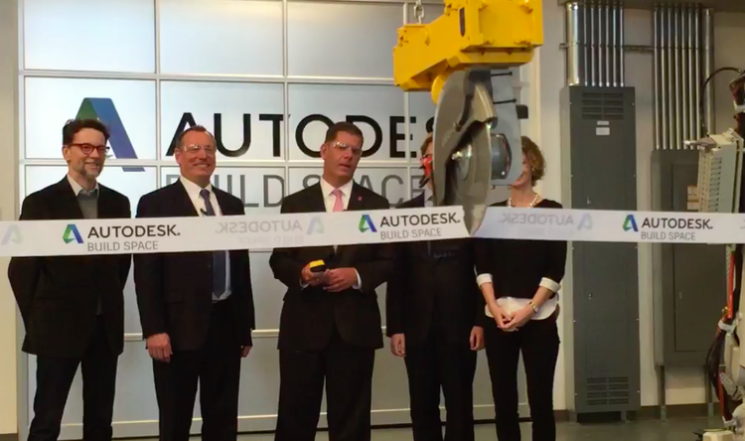
VR and AR are revolutionary, to be sure, but sometimes you still have to feel a physical thing, and see how it performs in real life, before you can truly make it better.
That is the thinking behind Autodesk Inc.‘s new 70,000-sq-ft facility, opened last week in Boston MA as part of a new 250-employee East Coast office. Dubbed BUILD, for “Building, Innovation, Learning, and Design”, the new space will serve as both innovation studio and start-up incubator. The Boston Globe described it as a “toy room of tools and and technologies for builders and designers.”
Sounds fun! So, the 35-year-old AEC software giant headquartered in San Rafael CA has built a physical playroom, 3,000 miles away from headquarters. The company says it will serve as a workshop and innovation center focused on next-generation construction techniques, with emphasis on spaces, equipment and training to advance digital fabrication, design robotics, and industrialized construction. According to Autodesk VP Jim Lynch, of the firm’s AEC product group, the intent is to assist the construction industry in embracing robotics and other technologies that have eluded it for years, but that manufacturing interests have developed to boost productivity and reduce waste.
“The feedback loop our team gains from being in such close close proximity to industry futurists is extraordinary”
“We think the cutting-edge work that’s going to take place in the BUILD space will enable our developers [and] be enabled by our developers,” Lynch told reporters. “It’s a pretty cool feedback loop to have.”
Added Autodesk CEO Carl Bass, “The feedback loop our team gains from being in such close close proximity to industry futurists is extraordinary… The way things are being designed, made and used is radically transforming, and Autodesk is fueling that change right here in Boston. The Autodesk BUILD space is a powerful place to influence the future of making things for the built world around us.”
The price of admission for prospective BUILD occupants? There isn’t any. Participants can pursue their innovations rent free, a win-win for all stakeholders, said Bass.

BUILD has sought to assemble all the required components to leverage that “feedback” loop to close the gap between innovation and implementation. Of particular interest in the new space is a 34,000-sq-ft fabrication lab that will feature nearly all materials involved in buildings and infrastructure, including steel, wood, stone, concrete, ceramics, glass, and composites such as carbon fiber.
Lab users are supported by more than 60 pieces of large-format equipment, including six industrial robots and 11 dedicated workshops involving wood, metal fabrication, composites, 3D printing, laser cutting, and a large-format control router and water jet cutter, according to Autodesk. A five-ton bridge crane also is on hand for large fabrication projects and transport of material and equipment between floors. “All this equipment ultimately allows us to improve the integration between our software and the world’s most advanced fabrication tools,” explained Autodesk in a statement last week.
Hopeful eight @ starting gate
Already, BUILD is working with eight start-ups, though Autodesk expects that number to double within a year. The first class includes fledgling Pillar Technologies, a data-driven risk management firm that monitors construction environments for hazardous conditions, including high humidity, mold growth, and even fire outbreaks.Joining BUILD’s start-up incubator has “allowed our team to create a next-generation product in a few weeks with minimal costs, something that would have taken established companies months and significant budget to create,” said Pillar co-founder Alex Schwarzkopf. “This is so valuable because as a start-up company, our scarcest resources are time and money.”
More physical resources may be on the way, too. If all goes as planned, Autodesk will expand the facility by another 15,000 sq ft in 2017, and another 30,000 sq ft may follow in the next 24 to 36 months, as well. That means AEC researchers, academics, start-ups, and students will soon have even more actual maker space to develop and test next-gen tools that previously may have only existed as computer code.





Discussion
Be the first to leave a comment.
You must be a member of the BuiltWorlds community to join the discussion.